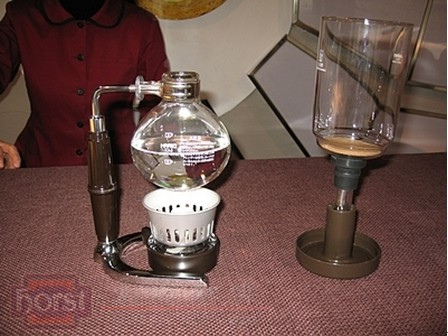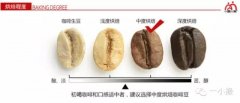Siphon coffee. What's the flavor of siphon coffee?
The siphon cooking process is similar to immersion extraction cooking, first a soaking process, and then a percolation extraction process of coffee liquor. The principle of making a cup of siphon coffee is the same as that of soaking extracted coffee, but requires more attention and skill. Today, a teacher from Chongqing Brista Coffee West Point Liquor Institute will share the mystery with you.
The superstition of siphon
Many coffee professionals are perplexed by how to make a cup of siphon coffee. So far, they have not seen a barista continuously make high-quality siphon coffee according to one method rather than luck. Until now, there is still a superstitious way to siphon coffee, and that is a frequently reprinted New York Times article in 2008. It quoted the owner of a famous coffee company as saying, "the goal is to form a deeper whirlpool by stirring no more than four times without touching the glass wall. Attitude is important." One pretentious roaster even claimed that it had coffee "specially baked for siphon" and even saw the extremely odd extraction method of "Japanese siphon champion" at a trade show demonstration.
How to operate a siphon kettle
The physical properties of siphon coffee may be complicated, but the process is not mysterious. Coffee has nothing to do with your attitude, handmade bamboo sticks or mixing techniques, because no matter what method is used, a good siphon pot can achieve a reasonable amount of uniform extraction from the whole range of coffee extraction at the right temperature.
When the upper kettle tightens the lower kettle, a closed system is formed, which contains water, air and steam. When the kettle is heated, the pressure of air and water vapor increases. When the pressure in the lower pot exceeds an atmospheric pressure, the water in the lower pot can be forced into the upper pot through the catheter at the lower end of the upper pot. It should be noted that although the air pressure in the lower pot exceeds an atmospheric pressure, the water inhaled in the upper pot does not need to boil.
Once the water level in the kettle falls below the conduit, the system is no longer closed, air and water vapor will overflow through the conduit, and the water slowly begins to boil. Due to the release of air and water vapor, another water vapor will be formed, and the ratio of water vapor to air in the kettle will increase. In order to achieve an effective seepage velocity, there must be a certain ratio of water vapor to air. If the water level in the starting pot is smaller than the capacity of the pot, then the steaming time will be longer in order to meet a certain ratio of water vapor to air.
After removing the heat source, the water vapor in the kettle cools and condenses, reducing the overall internal pressure. When the overall internal pressure is less than the external pressure, the liquid is forced to flow back to the next pot.
When refluxing, there will be a certain amount of friction on the wall of the upper pot, and the liquid will generally find the place with the least resistance to pass through, and the resistance around the upper pot will make the coffee liquid gather and flow down to the center. Therefore, the author recommends that at the beginning of the seepage, a slight stirring should be used to make a certain amount of coffee powder move away from the pot wall to the center, and a proper stirring can rebalance the resistance in the pot, thus making the extraction more uniform.

Important Notice :
前街咖啡 FrontStreet Coffee has moved to new addredd:
FrontStreet Coffee Address: 315,Donghua East Road,GuangZhou
Tel:020 38364473
- Prev

How do bakers learn? Learn coffee roasting
Whether you are an enthusiast who likes to buy beans to brew at home, or the owner of a coffee shop (who does not bake at home). You must have bought good beans for your experience from the same baker and had an unfortunate disappointment with him. I think in a good baker, there is no guarantee that every bean is baked perfectly. Similarly, the worst baker can be in the market.
- Next

High-quality coffee how to brew high-quality coffee
What is the basis of coffee making? Extraction is to balance the various flavors of coffee in the right way. Generally speaking, if the coffee production time is too short and the extraction speed is too fast, then the coffee taste will tend to be plain and sour coffee extraction is not enough; if the time is too long and the extraction speed is too slow, the coffee will become bitter and the coffee with metallic flavor will be overextracted. For every kind of coffee or
Related
- Beginners will see the "Coffee pull flower" guide!
- What is the difference between ice blog purified milk and ordinary milk coffee?
- Why is the Philippines the largest producer of crops in Liberia?
- For coffee extraction, should the fine powder be retained?
- How does extracted espresso fill pressed powder? How much strength does it take to press the powder?
- How to make jasmine cold extract coffee? Is the jasmine + latte good?
- Will this little toy really make the coffee taste better? How does Lily Drip affect coffee extraction?
- Will the action of slapping the filter cup also affect coffee extraction?
- What's the difference between powder-to-water ratio and powder-to-liquid ratio?
- What is the Ethiopian local species? What does it have to do with Heirloom native species?

